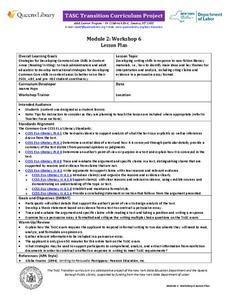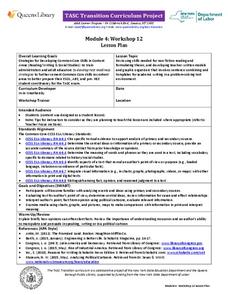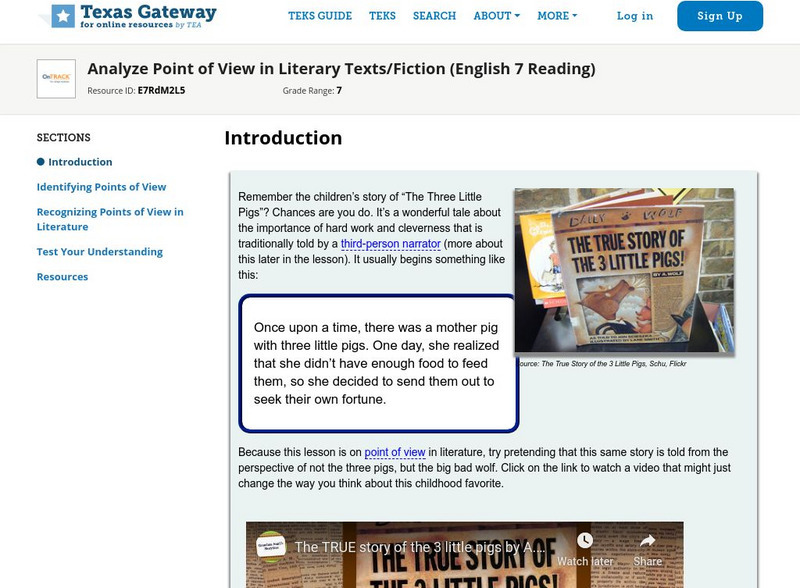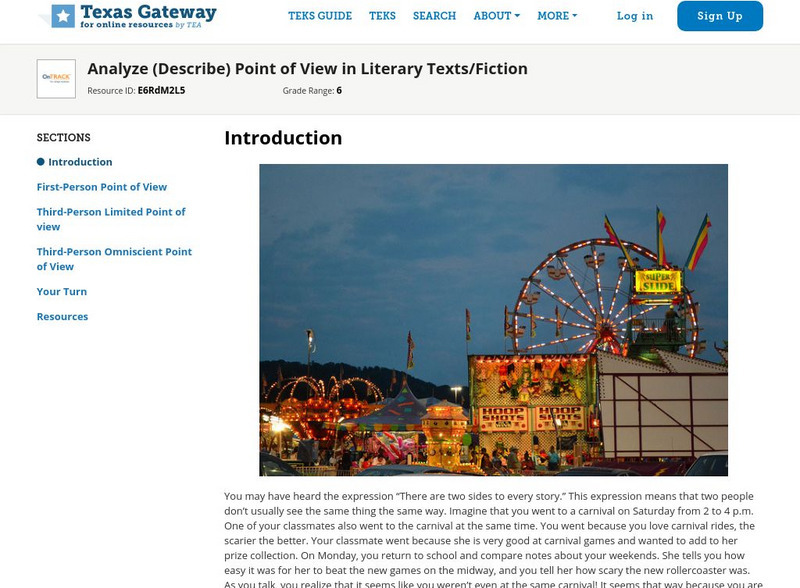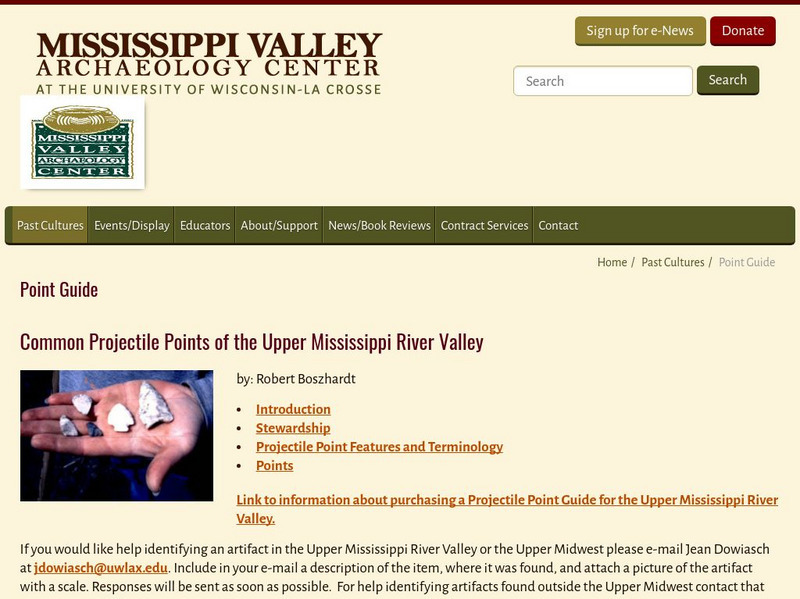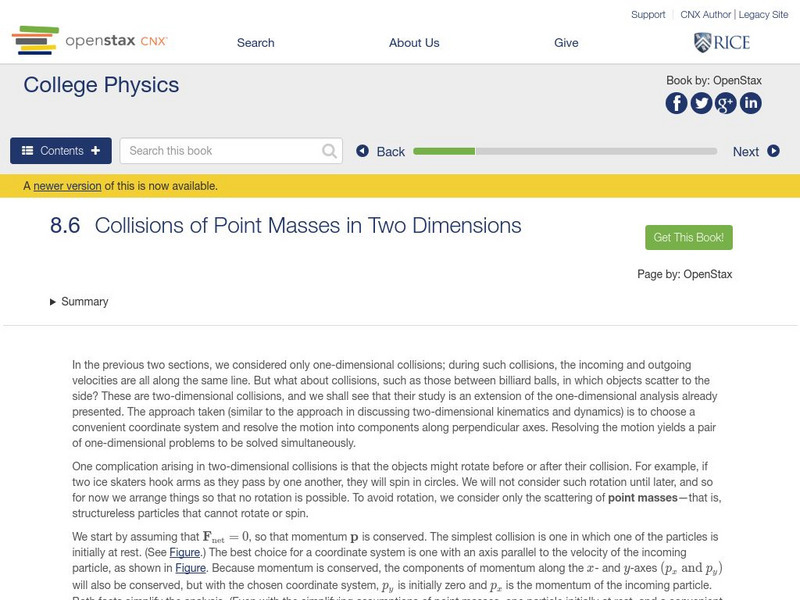EngageNY
TASC Transition Curriculum: Workshop 6
Is a college education necessary for success in today's world? The class investigates the question, along with others at the end of the sixth workshop in a 15-part series. The lesson has four parts with multiple activities and...
EngageNY
TASC Transition Curriculum: Workshop 12
How can opinions slant facts? Workshop participants learn how to examine primary and secondary sources and identify the author's point of view. They also examine how visual art impacts the meaning and rhetoric of sources. Full of...
National Humanities Center
Teaching The Great Gatsby: A Common Core Close Reading Seminar
The 41 slides in a professional development seminar model how to use close reading techniques to examine the many layers of F. Scott Fitzgerald's The Great Gatsby. In addition to passages from the novel, slides provide biographical...
Transforming Education
SEL for Educators Toolkit
Four resources make up the SEL toolkit for educators. Intended for those that teach kindergarten to twelfth grade, helpful files include a companion guide, presentation, reference list, and a one-page snapshot that neatly showcases the...
Intersectional Black Panther Party History Project, IPHP
Teaching the History of the Black Panther Party: 5 Essential FAQ’s
What are the facts about the Black Panther Party? Was it, as J. Edgar Hoover contended, a terrorist organization and a threat to national security? Or a group of indviduals bound together by a desire to protect and nurture their...
New York State Education Department
TASC Transition Curriculum: Workshop 7
Designed specifically for math instructors, the seventh workshop of a 15-part series allows time to explore Webb's DOK, ponder open-ended questions, and create lessons to apply what is learned. Teachers craft high-quality math problems...
Texas Education Agency
Texas Gateway: Analyze Point of View in Literary Texts/fiction
This lesson focuses on identifying points of view and recognizing points of view in literature.
Texas Education Agency
Texas Gateway: Analyze Point of View in Literary Texts/fiction
[Accessible by TX Educators. Free Registration/Login Required] In this lesson, students will learn to identify the primary points of view used in fiction and weigh the advantages and disadvantages of each.CCSS.ELA-Literacy.CCRA.R.6
Texas Education Agency
Texas Gateway: Understanding Literary Text: Point of View and Tone
[Accessible by TX Educators. Free Registration/Login Required] A learning module that teaches students about point of view and tone in six mini-lessons: Introduction, Reviewing Point of View and Tone, Unreliable Narrators, Third-Person...
Texas Education Agency
Texas Gateway: What's Your Point (Of View)? Practice 6 (English I Reading)
[Accessible by TX Educators. Free Registration/Login Required] A learning module that teaches students about point of view in six lessons: Introduction, A Different Perspective, Person of Interest, Center of Attention, Vantage Point, and...
Better Lesson
Better Lesson: Examining Point of View
Who is telling the story? Young scholars analyze whose eyes the reader is looking through. Students will learn that there is more to point of view than knowing who is telling the story. This lesson will teach them about the nuances of...
Texas Education Agency
Texas Gateway:analyze (Describe) Point of View in Literary Texts/fiction
In this learning module, students will learn to analyze fiction told from the first-person, third-person limited, and third-person omniscient points of view.
Texas Education Agency
Texas Gateway: What's Your Point (Of View)? Practice 6 (English I Reading)
You will be able to identify point of view and understand how it shapes fiction.
Concord Consortium
Concord Consortium: Stem Resources: Dew Point
For this experiment, students work to find the dew point temperature in their classroom, or the temperature at which water would condense. Includes questions for students to respond to online. Requires free registration in order to save...
Texas Education Agency
Texas Gateway: Humidity, Evaporation, and Boiling
By the end of this section, you will be able to explain the relationship between vapor pressure of water and the capacity of air to hold water vapor, explain the relationship between relative humidity and partial pressure of water vapor...
Cuemath
Cuemath: Point of Concurrency
Learn all about the point of concurrency. This lesson targets the point of concurrency of perpendicular bisectors, the point of concurrency of the angle bisectors of a triangle, and has interesting solved examples and practice questions.
Other
Mississippi Valley Archaeolgy Center: Common Projectile Points
This scholarly work describes the various projectile points used by Paleo-Indians and later cultures in the Upper Mississippi Valley. Find diagrams, photographs, and descriptions of the points, and compare their differences and...
Texas Education Agency
Texas Gateway: Humidity, Evaporation, and Boiling
Learn about the relationship between vapor pressure of water and capacity of air to hold water vapor, the relationship between relative humidity and partial pressure of water vapor in the air, and how to calculate vapor density,...
Texas Education Agency
Texas Gateway: Collisions of Point Masses in Two Dimensions
By the end of this section, you will be able to discuss two-dimensional collisions as an extension of one-dimensional analysis, define point masses, derive an expression for conservation of momentum along the x-axis and y-axis, describe...
Khan Academy
Khan Academy: Woodrow Wilson's Fourteen Points
The study resource from Khan Academy provides a video lesson for Period 7: 1890-1945 in American History. This lesson discusses President Woodrow Wilson's Fourteen Points. This resource is designed as a review for the AP US History Test.
Other
University of Wisconsin: Common Projectile Points
Site offers point guide as a means of identifying Clovis as well as points from other Paleoindian cultures.
OpenStax
Open Stax: College Physics: Humidity, Evaporation, and Boiling
A college textbook section that explores vapor pressure, relative humidity, and dew point. Section reviews how to calculate values like percent relative humidity. Section also includes problems and questions for the students to answer to...
Gilder Lehrman Institute of American History
Gilder Lehrman Institute: Ulysses S. Grant at West Point, 1839
[Free Registration/Login Required] A seventeen-year-old Ulysses S. Grant penned this letter to his cousin when he was a cadet at West Point revealing his first impressions of the academy. Also, includes a watercolor painted by Grant and...
OpenStax
Open Stax: Collisions of Point Masses in Two Dimensions
From a chapter on Linear Momentum and Collisions in a Physics textbook. This section of the chapter discusses collisions in two dimensions, what point masses are, how to calculate the conservation of momentum, what happens when two...
Other popular searches
- Point of View
- Authors Point of View
- Teaching Point of View
- 1 Point Perspective
- Plotting Points on Graph
- West Point
- Pointillism
- Power Point
- Boiling Point
- Author's Point of View
- Power Point Autobiography
- Geometry Lines Points Rays
